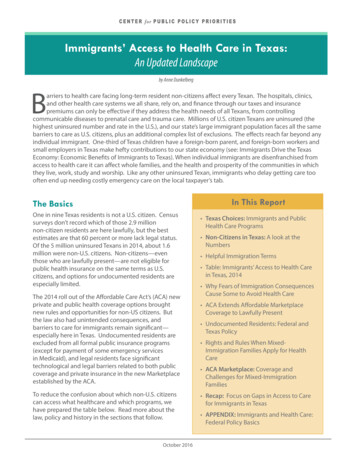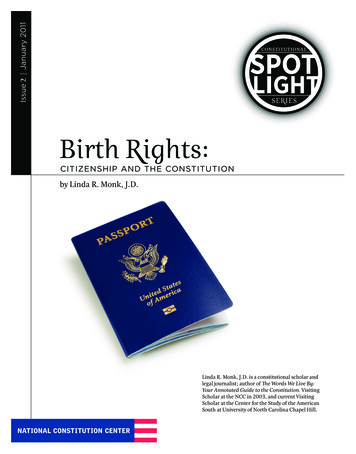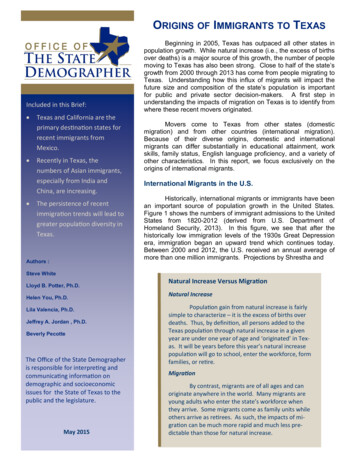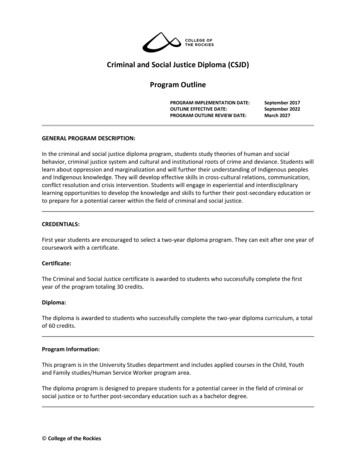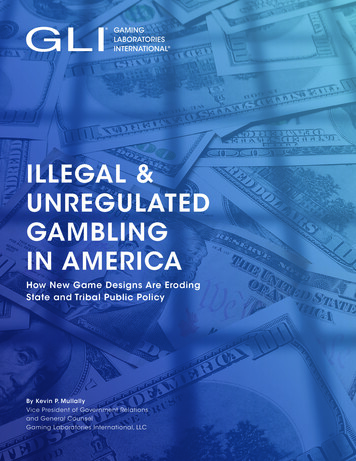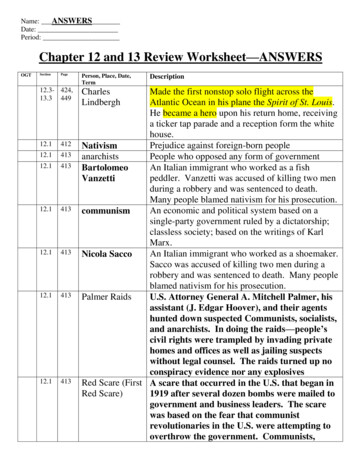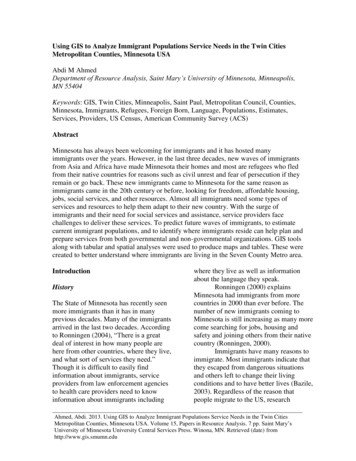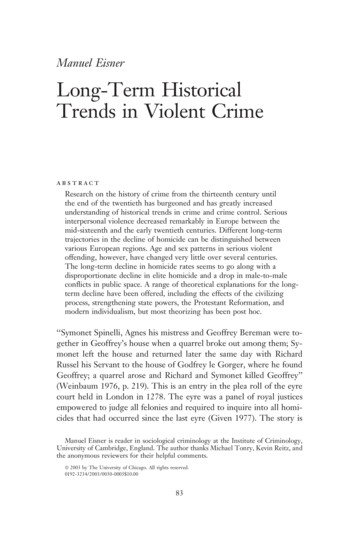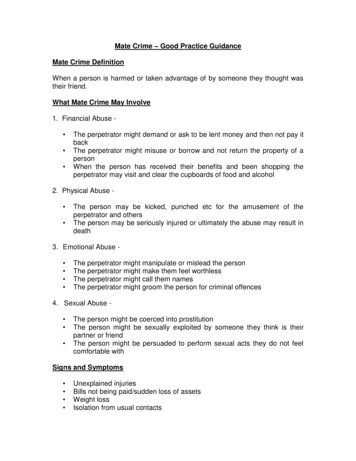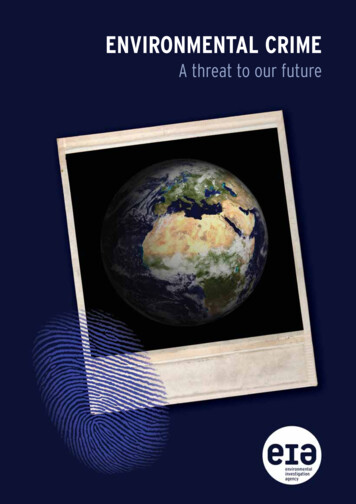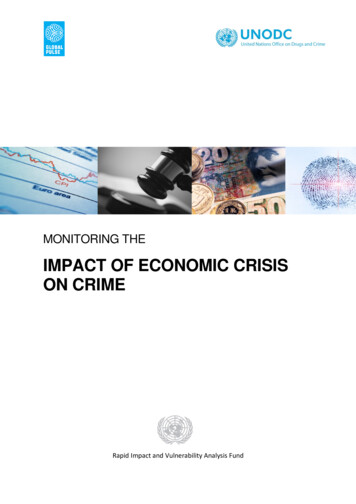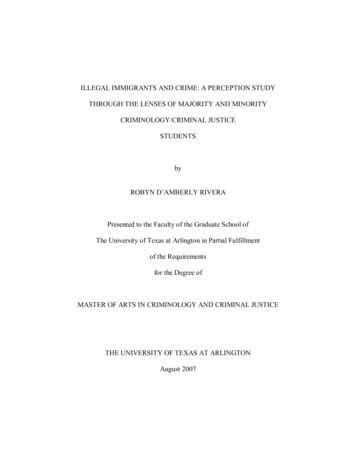
Transcription
ILLEGAL IMMIGRANTS AND CRIME: A PERCEPTION STUDYTHROUGH THE LENSES OF MAJORITY AND MINORITYCRIMINOLOGY/CRIMINAL JUSTICESTUDENTSbyROBYN D’AMBERLY RIVERAPresented to the Faculty of the Graduate School ofThe University of Texas at Arlington in Partial Fulfillmentof the Requirementsfor the Degree ofMASTER OF ARTS IN CRIMINOLOGY AND CRIMINAL JUSTICETHE UNIVERSITY OF TEXAS AT ARLINGTONAugust 2007
ACKNOWLEDGEMENTSI would like to thank my Major Professor, Dr. Alejandro del Carmen, whoguided me in the right direction through this process of graduate school. His words ofencouragement for school, work and family life have given me a greater understandingof how dreams can come true. In addition, I would like to thank Dr. John W. Stickelsand Dr. Rhonda R. Dobbs for their generous time and support.I would like to also share this accomplishment with one very special person, myfiancé, Ruben, for his love and continuous support and understanding of my drive tosucceed in reaching my goals and for sacrificing so many things so that I could focusmy time on the completion of this thesis. I would also like to thank both my parents,Roger and Josie for providing their guidance and strength to me in order to strive for abetter life through higher education. To my mother, whose love and faith as given methe opportunity to accomplish more than I could have ever dreamed. To my father, Ithank him for his words of wisdom, which have made me a better person and forcontinuing to instill in me the tools needed to succeed in life. Without these threeindividuals in my life, this experienced would not be possible.Finally, I would like to acknowledge my family members and friends whobelieved in me. This is an accomplishment that I share with you all.July 9, 2007ii
ABSTRACTILLEGAL IMMIGRANTS AND CRIME: A PERCEPTION STUDYTHROUGH THE LENSES OF MAJORITY AND MINORITYCRIMINOLOGY/CRIMINAL JUSTICESTUDENTSPublication No.Robyn D’Amberly Rivera, M.A.The University of Texas at Arlington, 2007Supervising Professor: Alejandro del CarmenThe purpose of this study is to examine the perceptions and attitudes of CRCJand Non-CRCJ (Criminology/Criminal Justice) majority (White/Caucasian) andminority (Black, Mexican American/Hispanic, American Indian, Asian/Pacific Islanderor Other) college students towards illegal immigrants and crime in the United States. Asurvey was administered to criminology/criminal justice university students thatexamined their perception and knowledge of illegal immigration and their impressionon whether illegal immigration and crime are correlated. It is found that the students’iii
overall answers to the survey showed that they did not perceive that illegal immigrationis related to crime in the United States.iv
TABLE OF CONTENTSACKNOWLEDGEMENTS.iiABSTRACT .iiiLIST OF TABLES .xiiiChapter1. INTRODUCTION .11.1 Statement of the Research Problem .21.2 Purpose of the Study .31.3 Significance of the Study.31.4 Definitions. .41.5 Plan of Presentation.42. LITERATURE REVIEW .62.1 The History of Mexican Migration to the United States .72.2 Demographic Characteristics of Undocumented Immigrants.102.3 Crime on the U.S.-Mexican Border .122.4 Use of Public Resources.152.5 Attitudes Toward Undocumented Mexican Immigrants .172.6 Options to Legally Migrate into the United States .202.7 The Effects of Immigration on the United States .212.8 Current Proposals to Modify Immigration Policies .23v
2.9 Border and Immigration Issues.252.10 Immigration and National Interest .273. METHODOLOGY AND DESIGN.293.1 Construction of the Self-Created Survey Instrument .303.1.1 Survey Instrument .303.1.2 IRB Review and Approval.313.2 Sampling Method .313.3 Data Collection Method .323.4 Statistical Manipulation.334. FINDINGS .344.1 Demographics .354.2 Majority and Minority Responses.374.2.1 Knowledge Items.374.2.2 Perception/Opinion Items .415. DISCUSSION AND CONCLUSION .485.1 Implications. .505.2 Contribution to the Body of Knowledge .525.3 Limitations of the Research .525.4 Criminology/Criminal Justice Majority and Minority Students 535.4.1 Knowledge. .535.4.2 Perception .535.5 Suggestions for Further Research .54vi
AppendixA. SURVEY INSTRUMENT .56REFERENCES .63BIOGRAPHICAL INFORMATION .66vii
LIST OF TABLESTablePage1Demographics of Survey Respondents .352Knowledge Based Differences among MajorityStudents and Minority Students. . 383Perception/Opinion Differences among MajorityStudents and Minority Students. . 42viii
CHAPTER 1INTRODUCTIONOne would agree that a recent panic over illegal immigration has brought moreawareness over the last couple of years with immigration policies becomingincreasingly more abundant as crime on the U.S. and Mexican borders increases. Alsoit could be argued that it has become more difficult to avoid the perception and attitudethat linked crime and illegal immigrants. It is possible that the presence of illegalimmigrants in the United States creates financial problems for the criminal justicesystem.A relationship between illegal immigration and border crime might beexpected for three reasons: illegal immigrants commit more crime; illegal immigrantsare more likely to be victimized by crime; and/or illegal immigrants use smugglers toenter the United States who then commit more crime (Orrenius & Coronado, 2005).According to Orrenius and Coronado (2005) there was little empirical evidence thatimmigrants – legal or illegal – commit more crime than natives (apart from immigrationrelated offenses which they are not considering here). When it come to the issue ofimmigration and crime, it does not seem to matter immigrants are legal or illegal forpeople to assume a connection (Orrenius & Coronado, 2005).While the number of illegal immigrants entering the United States annually canonly be estimated, data on apprehension are more reliably collected (Guerette & Clark,2005).Hawley (1999) states that there exists widespread concern among many1
Americans about the problem of illegal immigration.Some areas of the countryparticularly those Southern regions bordering Mexico, face a regular influx offoreigners coming into the country illegally (Hawley, 1999). Despite the fact that theborder states of Texas, New Mexico, California and Arizona experience more illegalimmigration that other states, the concern about immigration and crime are an issuethroughout the United States. Guerette and Clarke (2005) state that undoubtedly thelargest flow of illegal immigration into the United States takes place along the Mexicanborder.According to Orrenius and Coronado (2005), the number of apprehensions is notan ideal measure of the number of illegal migrants successfully entering the UnitedStates or even of the number attempting to enter. In addition to counting the number offailed attempted crossings instead of the number of successful crossings, the datainclude repeat apprehensions for the same individual (Orrenius and Coronado, 2005).Also, it needs to be taken under consideration that many immigrant crimes are notreported and could be possibly in greater proportion than the crimes that U.S. citizenscommit. One would agree that there are other factors for the underreporting. In fact,criminals that come from other countries, may cross over the border to commit thesecrimes and then return to their home country. It may be also that law enforcement maynot keep records on the national origin of the perpetrator.1.1 Statement of the Research ProblemThere are two important issues in studying the impact of illegal immigration oncrime (Orrenius & Coronado, 2005). According to Orrenius and Coronado (2005), first,2
there is the question of the casual nature of the link and second, there is an empiricalquestion regarding the measurement of illegal immigration, specifically the extent towhich INS (Immigration and Naturalization Service) apprehensions data capturechanges in the volume of illegal immigration. It needs to be understood is that theUnited States has not yet integrated law enforcement response to immigration control.1.2 Purpose of the StudyThe purpose of this study is to examine the perceptions and attitudes of y(Black,MexicanAmerican/Hispanic, American Indian, Asian/Pacific Islander or Other) college studentstowards illegal immigrants and crime in the United States. In addition, this study aimsto show the misrepresentation and misconceptions of illegal immigrants in the UnitedStates.1.3 Significance of the StudyThe author will discuss the findings of this study regarding the perceptions andattitudes towards illegal immigrants between CRCJ majority college students and CRCJminority college students. This study will bring more awareness to the CRCJ collegestudents regarding illegal immigrants in the United States and show what theirperceptions and attitudes are towards illegal immigrants. Furthermore, the findings ofthis study are important to illegal immigrants who are in the United States and who areconcerned with the misconceptions of their presence in connection with crime in theUnited States.3
1.4 DefinitionsFor purposes of the study, several terms have been defined. Attitude: Attituderefers to the manner, disposition, feeling, and/or position with regard to a person orthing. Perception: Perception is the process of acquiring, interpreting, selecting, andorganizing sensory information about a minority member and/or the environment thatindividual is surrounded in.1.5 Plan of PresentationIn this study, the sample is derived from students enrolled at the The Universityof Texas at Arlington during the Spring 2007 semester. CRCJ and Non-CRCJ majoritystudent(s) will be referenced as student(s) whose ethnicity is White/Caucasian. Inaddition, minority student(s) will be referenced as a student(s) whose ethnicity is Black,Mexican American/Hispanic, American Indian, Asian/Pacific Islander or other.It is not possible to generalize the results from this study to the generalpopulation due to the sample that was used in this study which was taken fromuniversity students in Texas. Their views may not be representive of other views ofstudents in other universities across the United States. Texas is one of four border statesof Mexico, so the opinions of the students may be more conservative than in other stateswhere illegal immigration may not be as much of an issue. It is anticipated that thisstudy will further the understanding of how knowledge impacts perceptions andopinions of illegal immigrants. Also, it will provide whether CRCJ and Non-CRCJmajors have a greater knowledge base regarding illegal immigrants and crime how thatmay impact their opinions.4
In chapter two, the author will present a review of the literature separated intoten subsections beginning with the historical overview of Mexican migration to theUnited States.In order to understand the reason behind the misconceptions andattitudes towards illegal immigrants, there needs to be an understanding of the overallsubculture of illegal immigrants.It is important to explain why there aremisconceptions of illegal immigrants in the United States. Illegal immigrants tend toreceive negative perceptions of their freedom due to the fact that they are in the UnitedStates illegally.And due to those perceptions, they suffer the disadvantages andconsequences that come along with them.In chapter three, the author discusses the methodology of the study while inchapter four, the author discusses the findings that were derived from the methodology.In chapter five, the author offers discussion and conclusions about the overall findingsas well as policy implications and suggestions for further research.5
CHAPTER 2LITERATURE REVIEWOne can agree that the growing concerns of undocumented Mexican immigrantsentering the United States has been an issue in recent years. According to Rozek (2003)the number of undocumented Mexican immigrants in the United States has increasedwhile there have also been an unprecedented number of people that are living in theUnited States illegally. It is important to keep in mind that the term “immigrant” isbeing defined as anyone who moved to Texas, whatever his or her place of origin(Rozek, 2003).It has been suggested that illegal Mexican immigrants are encouraged to ignorethe U.S. immigration laws and obtain employment in the U.S. The economy continuesto absorb the increasing numbers of illegal Mexican immigrants into the United Statesas they dominate the agricultural labor force and also occupy many other low-endoccupations and as this is occurring, so is the increasingly number of crimes on theU.S.-Mexican borders (Rozek, 2003).In the wake of September 11, 2001, with U.S. military action abroad in the nameof “fighting terrorism,” and the creation of new “national security” law andinfrastructures within the U.S., we are witnessing the establishment of a nationalsecurity state apparatus that threatens to undermine democracy within the U.S. andabroad (Jonas & Tataquin, 2004). Palafox (2001) states that it is especially intriguing6
that increased U.S.-Mexican border enforcement has taken place as these economies arebeing integrated (e.g. NAFTA), leading to a “borderless economy and a barricadedborder” (p.x).As part of the simultaneous “opening” of the border to trade andcommerce, while “closing” it to undocumented immigration and drug trafficking,border policing has attempted to create the image of a controlled border in an era ofmassive and potentially cataclysmic change (Palafox, 2001).2.1 The History of Mexican Migration to the United StatesMexican migration into the United States has occured for hundreds of years.Officially, U.S. visitors have unhindered access to Mexican border cities, but Mexicanvisitors to U.S. border cities need crossing permits (Ortiz, 2001). In order to understandthe attitudes that are associated with undocumented Mexican immigrants, it is necessaryto provide information and insight to the historical background of immigration.Certainly the situation, which creates the history of Mexican migration, isunique as much of the southwest region of the U.S. formerly belonged to Mexico(Skinner, 1987).Many would argue that the state of Texas has the most easilyaccessible borders with Mexico and thus has had the most increased labor population.The influence of the economy and politics has played an important role in the history ofMexican migration.Skinner (1987) stated that during World War I, Mexicans were needed in theUnited States for agriculture and railroad jobs. Thus, in 1917, the government institutedthe first bracero (Mexican labor) program to permit farm hands to work temporally inthe U.S. (Skinner, 1987). This was the beginning of the immigration policy that would7
ultimately provide for the U.S. regarding the needs of the economy. After the braceroprogram was terminated, there was still a significant number of undocumented workersthat were entering the U.S (Skinner, 1987).Undoubtedly, the largest flow of illegal immigration into the United States takesplace along the Mexican border (Guerette & Clarke, 2005). There has been a sharpincrease in the amount of illegal immigrants from Mexico coming into the UnitedStates. It is estimated that the number of illegal immigrant reached 500,000 or higherduring the late 1990s and may be as high as 11-12 million as of 2006. Martinez (1997)states that as Mexicans continue to migrate to the U.S., their experiences, interactions,and confrontations in the context of global capital bring new issues to bear upon thenational stage. As such, those new issues need to be examined and discussed.One might agree that there is a need to examine the history of the antiimmigration measures since the mid-1990s and the brief “political opening” forlegalization just before September 11, 2001.Jonas and Tactaquin (2004) identifyseveral important turning points in the history of immigration policies in the UnitedStates. The previous turning points were in the 1920s, with racially driven immigrationquotas and instituted family reunification as a major criterion (Jonas & Tactaquin,2004). Signaling concern over the growing presence of undocumented immigrants,Congress passed the Immigrant Reform and Control Act (IRCA) in 1986, after morethan a decade of political wrangling and the deliberations of a national commission onsweeping immigration reform (Jonas & Tactaquin, 2004).8
Jonas and Tactaquin (2004) state that a decade later, in 1996, following the 1994passage and subsequent overturn of Proposition 187 in California (which would havedenied all public services to undocumented immigrants), Congress passed a trio of threelaws that went far beyond Proposition 187 in their attack on immigrants.Theyconsisted of the Illegal Immigrant Reform and Immigrant Responsibility of 1996, TheAnti-Terrorism and Effective Death Penalty Act (AEDPA) of 1996, and The PersonalResponsibility and Work Opportunity Act (PRWOA, more commonly known as theWelfare Reform Act) of 1996. These laws are in connection with the many complaintsthat have been reported that law enforcement officials have violated their human andcivil rights (Jonas & Tactaquin, 2004).Huspek, Martinez, and Jimenez (1998) state that the violations of human andcivil rights include illegal search of persons and their private property, verbal,psychological, and physical abuse of persons, child abuse, deprivation of food, water,and medical attention, torture, theft, use of excessive force, assault and battery, andmurder. The complaints are directed at a number of law enforcement agencies locatedprincipally in Southern California, including the U.S. Border Patrol, U.S. Customs, U.S.Port Security, the Sheriff’s Departments of San Diego’s, Vista, San Marcos, Fallbrook,and Riverside, the San Diego Police Department, the California Highway Patrol, andthe California National Guard (Huspek, Martinez, & Jimenez, 1998).The Immigration and Naturalization Service (INS), including the U.S. BorderPatrol, is mentioned most frequently in the majority of the complaints (Huspek,Martinez, & Jimenez, 1998). Huspek, Martinez, and Jimenez (1998) stated that the9
subjects responsible for voicing the complaints included 267 individuals who are highlydiverse with respect to age, social class, gender, life ambition, and legal status. Theyalso stated that many are undocumented immigrants, but many others are holders ofvalid border crossing cards as well as citizens and legal residents of the United States(Huspek, Martinez, & Jimenez, 1998).2.2 Demographic Characteristics of Undocumented ImmigrantsThe demographic characteristics of undocumented immigrants need to bediscussed in order to understand why there are such perceptions of undocumentedimmigrants and the issues that have become a topic for discussion in today’s society. Itis difficult to obtain accurate information regarding the size of the population ofundocumented Mexican immigrants.Some might argue that it is clear that mostundocumented Mexican immigrants that migrated to the United States were male. Thisslight excess of males may be due to them establishing themselves in the U.S. with theintention of later sending for their families (Skinner, 1987). Most of them were highlyconcentrated in the young-adult working ages in which they would be able to participatemore in the labor force. Skinner (1987) stated that although undocumented workers canbe found in all occupational groups and wage levels, certain occupations haveconcentrations of them. Most of these workers tended to have jobs in agriculture, foodretailing, and construction, which tend to be lower wage jobs.It could be agreed that economists believe that immigration is a net benefit to theU.S. economy. Immigrants fill jobs that U.S. citizens often reject and thus help theeconomy and provide job creation for a group of individuals that may be in a strained10
atmosphere. Also employers ranging from small business owners to major corporationsmight choose to hire foreigners who often work harder for less pay than U.S. citizens.Skinner (1987) stated that most undocumented Mexican immigrants tend toreside where there is a large population of legal immigrants thus making it moredifficult to be noticeable as an illegal. Almost half of the undocumented immigrantscounted in the 1980 census were in California (Skinner, 1987). New York had 11%,Texas 9%, Illinois 7%, and Florida 4% (Skinner, 1987).Legal and illegal Mexicans have increased rapidly and are soon becoming themajority and not just the minority any longer. This group of individuals has risen toextraordinary levels and positions in politics and in the community in which they live.Currently, immigration accounts for an increase of about 1.5 million people a year,which represents more than half of the total U.S. population growth (Skinner, 1987).Many might agree that Mexican immigrants command some of the lowestearnings of all U.S. workers. According to Catanzarite and Bernabe Aguilera (2002),Latinos are hired disproportionately into relatively undesirable positions and also thatLatino representation tends to suppress pay in those occupations where they areprevalent.Phares (2000) explains that it is important to note that the largest lawenforcement agency in the country right now is the Immigration and NaturalizationService (INS), with its uniformed branch. Also according to Phares (2000) the U.S.Border Patrol with a budget of four billion dollars and it does joint operations with local(law enforcement) groups, as well as the military. According to studies by the Urban11
Institute in Washington, D.C. although statistically only four out of the 10undocumented people in the United States cross the southern border (the others come inlegally through airports or seaports or at the Canadian border), 85% of the INS/Borderpatrol resources aimed at stopping undocumented migration are placed at the U.S.Mexican border (Phares, 2000).There were a number of changes made prior to September 11th with respect tolaw enforcement at the border. These changes, however, did not decreased the numberof people who came across the border. Phares (2000) explains that people continue tocome; the only result of border enforcement was the consolidation of the clandestinetrafficking industry, including making the industry of coyotes or polleros or pateros, thesmugglers, or the industry of false documents, more profitable.2.3 Crime on the U.S.-Mexican BorderAccording to Green and Ciobanu (2006), they examined the number ofimmigration prosecutions in the four years (2000-2004) surged from 16,724 to 37,854,making immigration prosecutions the single largest category of federal crimes,surpassing even drug prosecutions. Although the U.S.-Mexico border region has had along history of militarism and violence, only in the last few decades has increasingintegration of U.S. military armed personnel with civilian law enforcement beendocumented (Palafox, 2000).Crime that occurs on the U.S.-Mexican border is easily blamed solely onMexican Immigrants. The “crime problem” must be defined with care, lest the poor,who are the principal victims of crime, be represented in mass as its perpetrators12
(Binford, 1999). This has become a topic for discussion regarding illegal immigrantsthat cross the border into the United States.Many feel that illegal immigrants that come into the U.S. have increased theamount of crime along the border. Binford (1999) states that the print and broadcastmedia inundate the public with stories of documented links between narcotraffickers,politicians, and military officers, corruption and brutality in the Judicial Police,profiteering on the sale of state enterprises, and murderous intrigues within the rulingparty.Some might argue that crime is not occurring on the U.S.-Mexican border solelyby Mexican immigrants, but is also being committed against Mexican immigrants. Onemight agree that the crime that occurs on the U.S.-Mexican borders is largely associatedwith drug trafficking, human trafficking and other illegal enterprises. This is true for themost part, but Mexican immigrants are not solely committing these acts.Adding even greater controversy to Illegal Immigration Reform and ImmigrantResponsibility Act, Congress expanded the list of deportable crimes, including suchminor offenses as shoplifting, petty theft, drunk driving, and even low level drugviolations which have been reclassified as aggravated felonies, a category that includesmurder, rape, terrorism, and kidnapping (Welch, 2003).The Border Patrol implemented several focused and later expanded operations inselect border areas aimed at preventing and detecting illegal entry along the border(Guerette & Clarke, 2005). According to Guerette and Clarke (2005), there have beentwo unanticipated consequences of the border strategy – an increase in human13
smuggling and in migrant deaths. As it is reflected, this is occurring against MexicanImmigrants.Not all illegal immigrants are coming to the United States and committingcrimes. They are simply coming into the United States to find jobs in order to providefor their families in Mexico. The population of workers trying to cross the borderillegally is ever more diverse according to Rivera-Salgado (1999). The distinguishingsocioeconomic profile of the new migrants from rural Mexico can be summarized asfollows: the majority of the new migrants come from regions within states that were nottraditionally characterized by out-migration of workers to the United States, many ofthem are indigenous, and there has been a substantial increase in the number of womenand children (Rivera-Salgado, 1999). It goes to show that most Mexican migrants arecoming to the United States for better opportunities. They simply want to be able tohave the American dream and provide financially for their families back in Mexico.Mexican migrants come to the United States on a very low profile in order to workduring the day and return to their homes in Mexico at night. They most likely try toavoid any focus on themselves in order to not bring any attention to themselves.As the laws and immigration policies increase, Mexican migrants continue tokeep a low profile. According to Welch (2003), looking at the crackdown on illegalimmigrants and criminal aliens from the perspective of irony sharpens our view of howstrict new laws have compounded the problem as well as created others (e.g., a massiveincrease in detained immigrants, racial discrimination, denials of due process, andvarious human and civil rights violations).14
By June 1997, violence along the 2,200-mile U.S.-Mexican border, which hadbeen escalating for years, had become so intolerable that U.S. Rep. Duncan Hunter (RCalifornia) said from the House floor that portions of the border were more dangerousthan Bosnia (Doughtery, 2004). Doughtery (2004) states that while America is beingoverrun by illegal immigrants it can not absorb, it is also being swamped by a sea ofdrugs for the same reason, thus the will does not exist in Washington to enforceAmerica’s legitimate borders. It should be understood that crime does occur by themeans of illegal immigrants.What needs to be understood is that not all illegalimmigrants are committing crimes along the
CRIMINOLOGY/CRIMINAL JUSTICE STUDENTS Publication No. _ Robyn D Amberly Rivera, M.A. The University of Texas at Arlington, 2007 Supervising Professor: Alejandro del Carmen The purpose of this study is to examine the perceptions and attitudes of CRCJ and Non-CRCJ (Criminology/Criminal Justice) majority (White/Caucasian) and
